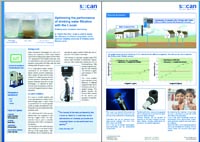In Puerto Rico the i::scan is used to asses the efficiency of different coagulants and to optimize cleaning protocols of drinking water filtration units.
Optimizing the performance of drinking water filtration with the i::scan

Background
Background
Green Innovation Technologies Inc. (GIT) is installing and operating surface water filtration units for the drinking water supply in Puerto Rico. The replacement of old systems with new, modern water filtration plants ensures that the people served by these plants will enjoy safe and clean drinking water for years to come. GIT is using silicon carbide ceramic membranes for the fi ltration units. Silicon carbide ceramic membranes offer a longer life cycle and are more resistant to in deep cleaning methods as their polymeric membranes counterparts.
However, since this is a new technology, it is important to determine the optimal operating conditions in terms of coagulant dose and cleaning cycles.
s::can’s solution
An i::scan is installed together with a con::lyte terminal to monitor the filtered drinking water. s::can’s i::scan is a powerful tool for monitoring water quality, providing cost-effective monitoring with very low maintenance and operation costs. TOC, UV254 and NTU of the raw and filtered water are measured in real time by a single i::scan. The measurement data is used to calculate how much of the TOC is removed by the filtration. The raw water at the intake has only little turbidity and a low level of solids (left cup in the image above). With the fi ltration unit it is possible to concentrate the organic matter (middle cup) and reduce the TOC content of the water. TOC removal is important because lower TOC means lower formation of disinfection byproducts and other undesirable substances such as trihalomethanes. But excess coagulant dosage will only increase cost without a significant increase in TOC removal. The i::scan enables quick evaluation of the efficiency of different coagulants and aids in finding the optimal coagulant dosage. This greatly reduces the time and effort needed for the start-up and operation of new fitration plants.
